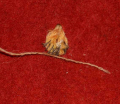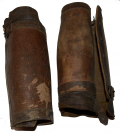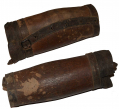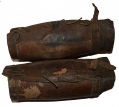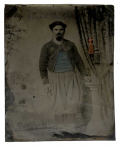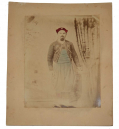site search
online catalog
ZOUAVE FEZ, JAMBIERES, HALF-PLATE TINTYPE AND PERIOD ALBUMEN COPY PHOTO OF JOSEPH MILES 53rd NEW YORK, D’EPINEUIL ZOUAVES, IN UNIFORM WEARING THE FEZ
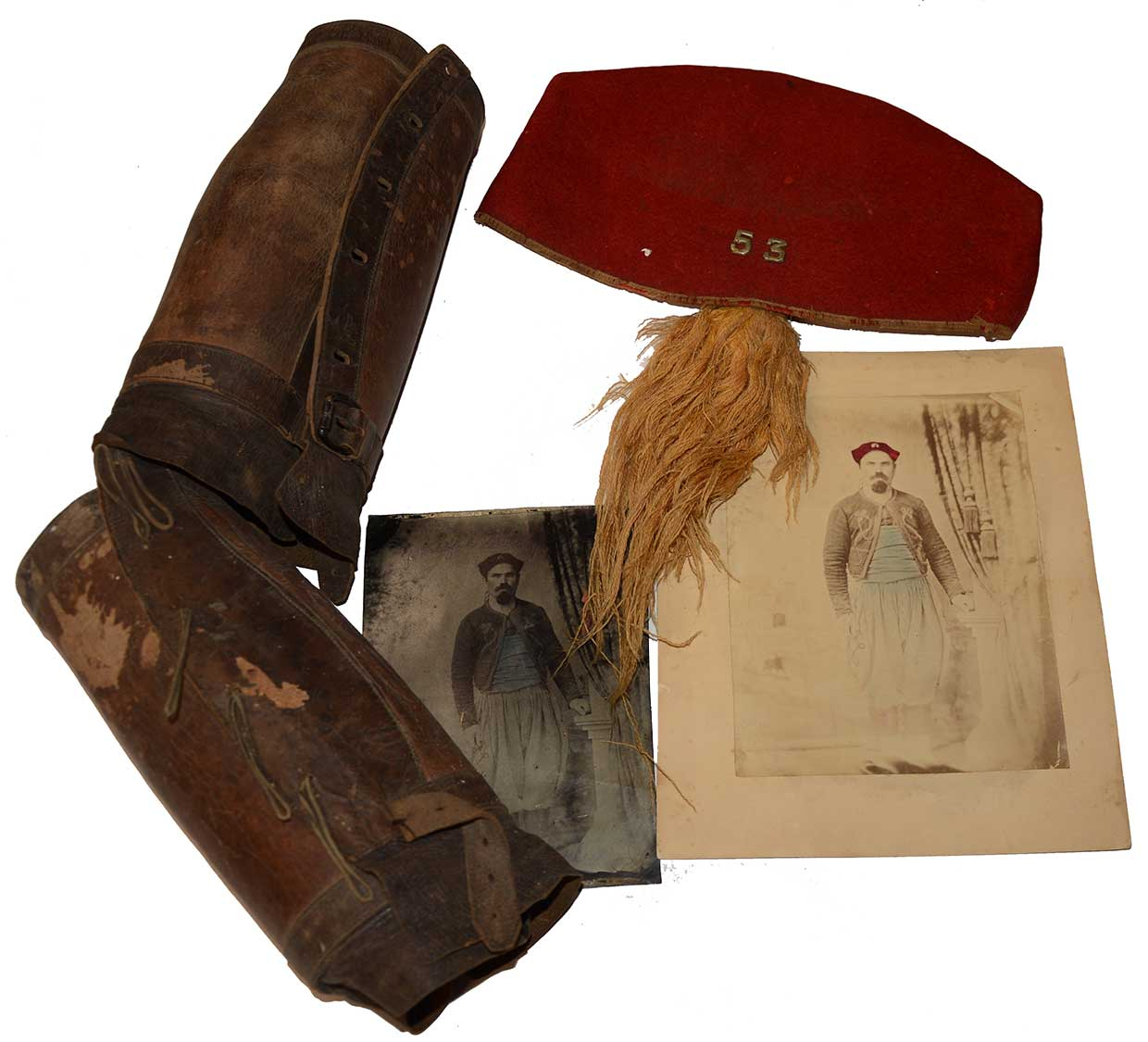
$6,000.00 SOLD
Quantity Available: None
Item Code: 480-360
This is an excellent identified Civil War zouave fez and pair of jambieres (leggings or greaves) worn by a soldier in the 53rd New York Volunteers, the “D’Epineuil Zouaves” along with a half-plate tintype (and a period albumen copy) of him in uniform wearing the fez insribed “Joseph Miles” at top and at bottom, with the addition “James Miles Father.” The regiment was uniformed in keeping with the zouave craze that hit America about 1859-1860 with many militia units adopting the colorful, exotic uniforms and light infantry drill of those French Algerian troops. In this case the regiment was raised by one Lionel Jobert D’Epineuil, a purported former French Army officer, authorized to raise a regiment as Colonel on August 2, 1861, with the expectation he would draw recruits of French extraction from the New York city area. A period newspaper reported, “The uniform of the men is an exact copy of the 6th Regiment Imperial Zouaves of France, and is to be completed by Messrs. Brooks Bros., by special agreement with the War Department. It consists of red fez cap with long yellow tassel, dark blue jacket trimmed with bright yellow braid, blue sash, and yellow and black leggings duck gaiters.” Even that extensive catalog omitted their yellow-trimmed dark blue vest and light blue trousers.
The fez is red felt, in excellent condition, with strong color a bound edge, with the numerals “53,” about 9/16 inch tall, pinned 1-inch from the lower edge. These are visible in the tintype and albumen copy photo. The tassel is a slightly faded yellow made from two cords extending about 3 inches down from the top center to a ½-inch turkshead knot with an 8-inch fringe. There are a couple of small spots of shallow moth tracking, but no holes. The jambieres (leather greaves or leggings) are about 9 ½ inches tall overall, with top edge being soft leather 1 ½-inches wide and the body being stiff, hard leather with ¾-inch bands along the top and bottom and along the edges of the vertical opening. These were designed to gather the lower portion of trousers and hold them in place, with leggings below them and gaiters fastening over the shoes. The condition is excellent, the leather has oxidized slightly toward a brownish black on the bands and medium brown on the body with some scuff. They fasten from bottom up by lacing five leather loops through five slits, each locking in place the one beneath it with the top loop secured by running through it a narrow belt and buckle fixed along the top that would hold the upper edge closed, just below the short, flexible black flap.
The tintype shows Miles full standing in the regiment’s zouave uniform. The wears a sash wound broadly around his waist and lower abdomen, thinly tinted light blue by the photographer. He stands before a painted backdrop with studio column and drape on the viewer’s right. One of the drapery cord knots was also tinted and now shows as a thin pink. His fez appears to have been tinted a deep red and is now a very dark maroon. The albumen copy is the same size, was mounted on cardstock for framing, and shows a definite red added to the fez and light blue to the sash and upper trousers. The tintype is bit light, mostly on the lower third. His facial features are strong and show a man in his thirties with heavy mustache and goatee. The albumen shows additional fading, but is good on the main part of the figure, from hips up.
Miles was born in Ireland about 1828. When he came to the US is unclear, but he enlisted at New York City Dec. 26, 1861, giving his age as 30, and was mustered into Co. K of the D’Epineuil Zouaves, 53rd NY Vols. the same day as a private for three years. The regiment as whole had departed for Washington on November 18, but apparently left behind a recruiting cadre since they were chronically short of men, though there had even been talk of forming a second battalion. The men had been mustered in piecemeal from August 27 to November 15, and had only been officially organized on October 12, with French character of the regiment quite diluted: the enlisted men came from all over the state and included a company of Tuscarora Indians from western New York. The regiment left for Washington November 18, was posted to the Washington area and then sent to Annapolis in preparation for joining Burnside’s expedition to the North Carolina coast.
They boarded ship on January 9, so whether Miles made it there in time for the trip is unclear, but he likely regretted it if he did. Some 700 men were crammed into quarters for 300 and the voyage was supposed to take six days, but lasted a month. The ship grounded on its way out of Annapolis, sailed to Fortress Monroe and headed for Hatteras, where it was blown out to sea, eventually being towed back to Monroe, then made its way back to Annapolis on Feb. 5, and then back to Monroe again because it drew too much water to get back into Annapolis. By the time they hit dry ground again, they spent a total of 34 days aboard the vessel. One of the few to get off the ship during the whole voyage was the Lieutenant Colonel, who had been involved in a vicious feud with the Colonel, but managed to join Burnside’s troops at Roanoke, where he was killed in action on February 8.
The regiment had been plagued by quarrels among the officers, disciplinary problems and desertion even before the voyage. D’Epineuil blamed unavoidable circumstances for its demoralized state on its return. McClellan and others blamed D’Epineuil, who faced a court martial and was not helped by the revelation he had not been a French army officer after all. McCellan solved the problem by breaking up the regiment, transferring two companies to other units and discharging the rest. Miles was officially mustered out March 21, 1862, at Washington.
Miles either returned to central New York or decided to settle there after his discharge. He shows up as a farmer in Preston, Chenango County, NY, in 1863, age 35 and unmarried, and he signed up in the army again in nearby Pharsalia on Jan. 1, 1864, mustering in as a private in Co. L of the 20th New York Cavalry. That unit was attached to the 18th Corps in the Army and Department of Virginia and North Carolina, and then with the Army of the James. It was active at Suffolk, Currituck, Chuckatuck, Wood's mills, South Quay, Winton, N. C., Guiam's ford, N. C., Jamestown island, Murfree's depot, siege of Petersburg, Darbytown road, campaign of the Carolinas, and in the Appomattox campaign, suffering seven enlistedmen killed or mortally wounded. Miles survived to muster out with the regiment on July 31, 1865, return to farming and marry. He died December 24, 1893, in Sidney, NY, survived by his wife and son, James B. Miles. His tombstone mentions only his cavalry service, but he retained these mementos of his earlier first service, which was, if nothing else, colorful and an adventure. [sr] [ph:L]
~~~~~~~~~~~~~~~~~~~~~~~~~~~~~~~~~~~
THIS ITEM, AS WITH ALL OTHER ITEMS AVAILABLE ON OUR WEB SITE,
MAY BE PURCHASED THROUGH OUR LAYAWAY PROGRAM.
CLICK HERE FOR OUR POLICIES AND TERMS.
THANK YOU!
Inquire About ZOUAVE FEZ, JAMBIERES, HALF-PLATE TINTYPE AND PERIOD ALBUMEN COPY PHOTO OF JOSEPH MILES 53rd NEW YORK, D’EPINEUIL ZOUAVES, IN UNIFORM WEARING THE FEZ
For inquiries, please email us at [email protected]
Most Popular
Historical Firearms Stolen From The National Civil War Museum In Harrisburg, Pa »
Theft From Gravesite Of Gen. John Reynolds »
Fine Condition Brass Infantry Bugle Insignia »
Selection Of Unframed Prints By Don Troiani »
Wonderful Condition Original Confederate-Manufactured Kepi For A Drummer Boy Or Child »
featured item
CONFEDERATE GENERAL LUNSFORD LINDSAY LOMAX AS A WEST POINT CADET IN DAGUERREOTYPE BY ANSON CA. 1854/55, EX-BILL TURNER COLLECTION
Formerly in the collection of Virginia collector and dealer Bill Turner this ninth plate cased daguerreotype by Rufus Anson of New York City is extremely clear, nicely cased, has a mat showing the photographer’s name and address, and shows later… (1138-1905). Learn More »









